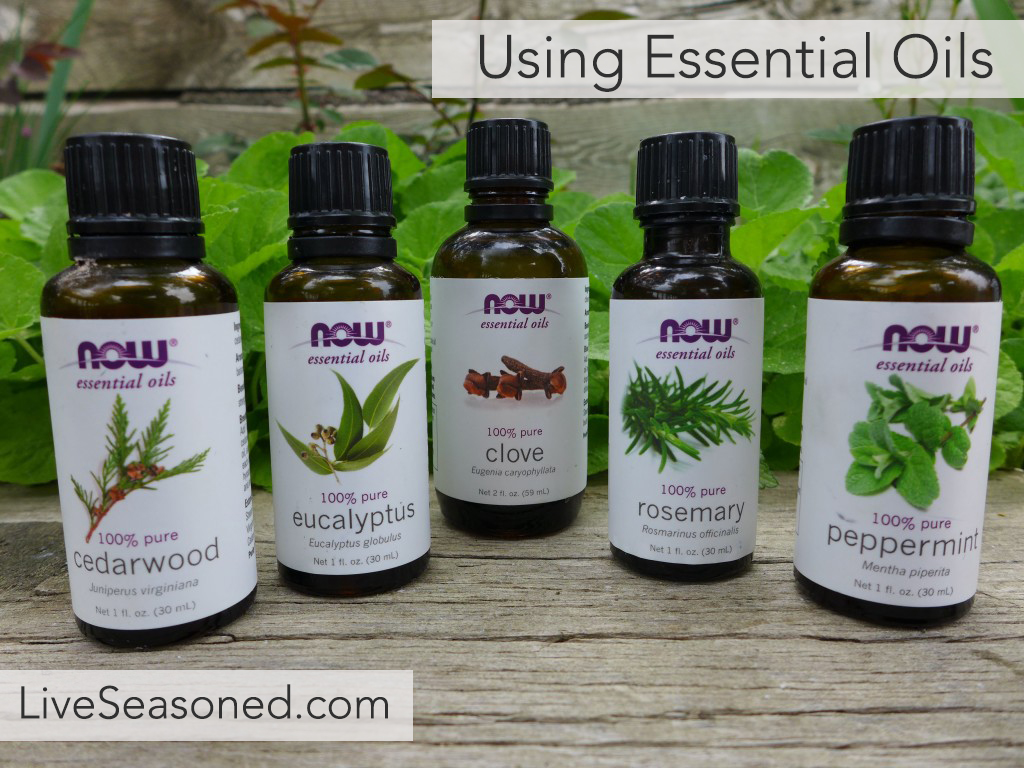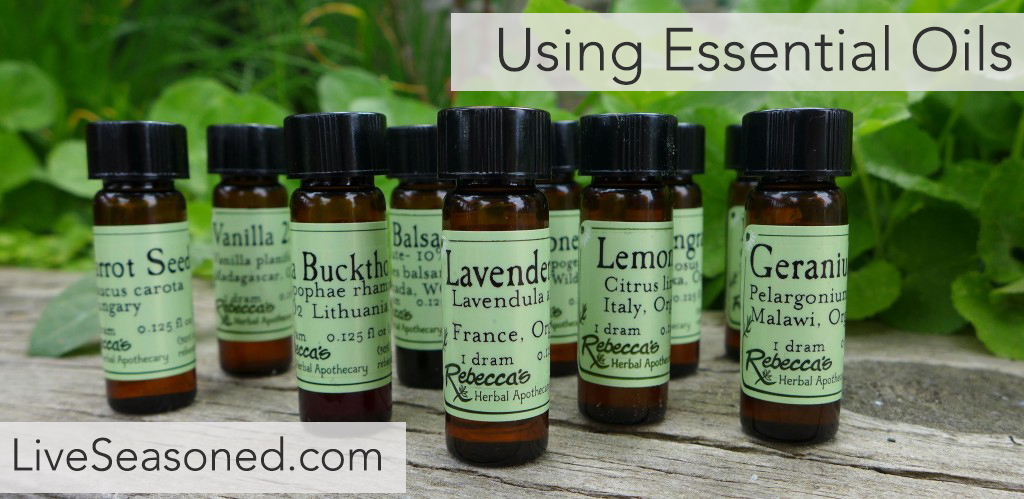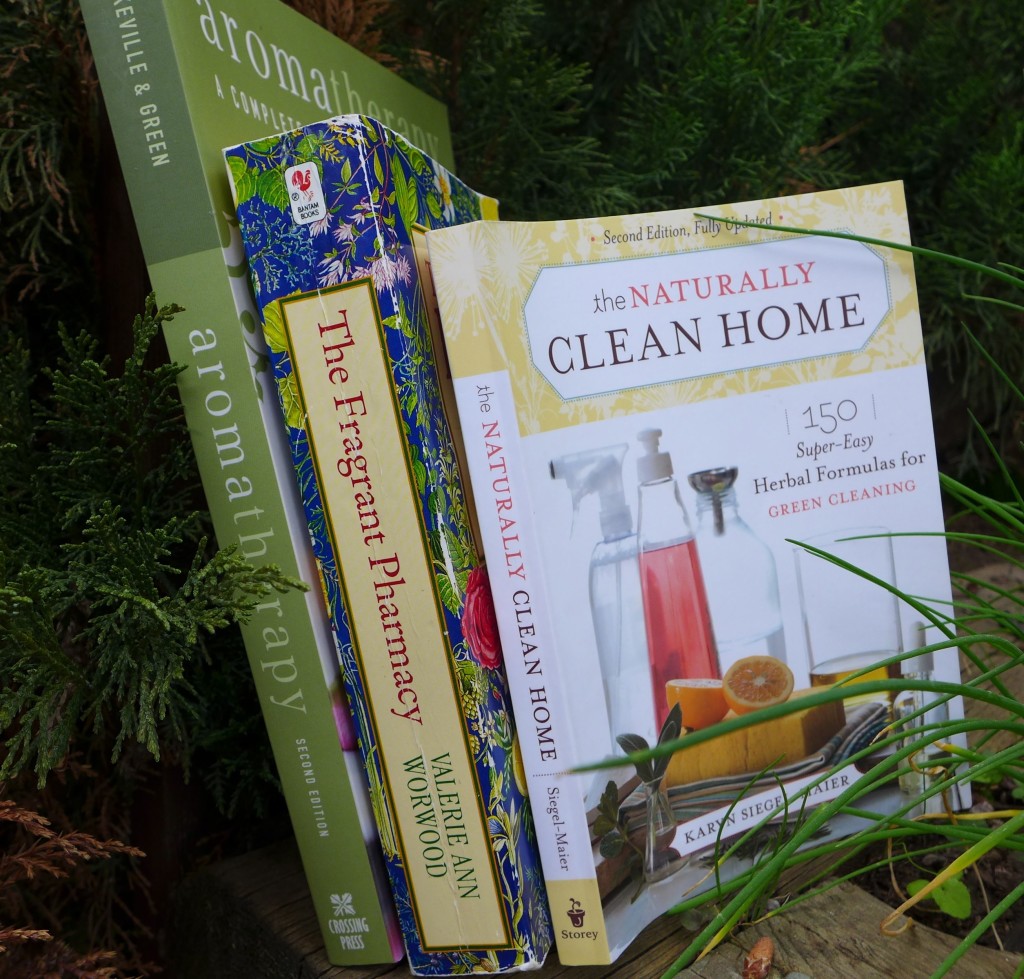This is the first of a multi-part series on using essential oils in the home and on your body. Excited to make some potions? We already have some essential oil uses in our archives.
Wherever I can, I’ve been trying to eliminate chemicals from our home, and introduce more natural alternatives, whether we’re talking cleaning products for the bathroom, cosmetics, or even pharmaceuticals. What I’ve found again and again is that essential oils are often recommended as a natural source for ingredients in many of my replacement recipes. The world of essential oils is vast, and I’m just starting to really explore all that these oils have to offer, but I thought it would be fun to start a little series this summer where I share with you what I’m learning and the useful resources I’ve found both online and off. As I’m just starting this series, I think it’s important to note that even if you’re buying high quality essential oils, while these are natural products, if used incorrectly they can be just as dangerous as manufactured chemicals.
In this post I wanted to cover some basics about essential oils, focusing on what they are and a few examples of how they can be used. At the bottom of this post I share some of the resources that I’ve found particularly helpful. And we couldn’t end the day without a recipe, so in a second post this afternoon I’ll share one of my favorite potions for keeping our shower clean and smelling fresh.
What are essential oils?
Essential oils are volatile aromatic compounds that contain the “essence” of a plant’s fragrance. Essential oils can be collected by mechanically squeezing plant material, using a solvent for extraction or by distillation. Distillation is by far the most common method of extracting essential oils. To distill the oils, steam is passed through plant material, heating up and vaporizing the aromatic compounds in the process. These compounds are collected as they return to their liquid state when cooled. While we often focus on the use of essential oils for their scent, I’m just beginning to understand and explore a variety of uses for these oils that goes beyond aromatherapy.
Common Uses
The categories below are not mutually exclusive, but are the ways I think of using essential oils within my home. Commonly, a characteristic that makes an essential oil useful in one category applies to how it’s used in other categories too. For example, tea tree oil is known to have powerful antifungal properties; this makes it a key ingredient in many homemade cleaning products as well as having medicinal & cosmetic properties if used for treating athlete’s foot or dandruff, two ailments often caused by fungal infections of the skin. Attractive, no?
- aromatherapy ~ We all know how quickly the different scents can influence our mood, and you may be most familiar with using essential oils for aromatherapy purposes. For example, even if you haven’t used essential oils, you’ve probably experienced the calming nature of lavender, the invigorating scent of peppermint, or the simple comfort from a whiff of vanilla. Opening a jar of essential oils from any of those plants will release the scents that evoke the same feelings.
- medicinal ~ Many commercially available drugs were originally derived from plant compounds, so it should be a surprise that essential oils have been used for medical purposes. Even so, this is considered a form of alternative medicine. Personally, I would not medicate with essential oils unless under the supervision of a trusted expert in the field, because you have to be extremely careful about purity and dosage of the oils, and of course you would want there to be some strong, documented evidence about their effectiveness for a given use. That said, the antiseptic, antibacterial, antimicrobial, and antifungal properties of many essential oils have been found to be beneficial when treating a variety of skin ailments.
- cosmetic ~ Essential oils contain vitamins and antioxidant content as well as having the aforementioned antibacterial, antiseptic, and antifungal properties, making many oils useful for skin care.
- pest control ~ The scents from a number of essential oils are known to deter or repel insects and rodents.
- cleaning ~ The antibacterial, antifungal, antimicrobial, and antiseptic characteristics make them extremely valuable components of many natural cleaning products.
For any of the uses listed above, the only tools you’ll need to make your potions are storage bottles for the final products, measuring spoons and cups, and markers for labeling your products. All items I’m sure you already have in your house.
*I can’t leave this section without a word of warning. As I’ve mentioned a few times, essential oils are highly concentrated and can be an irritant or poison if used incorrectly. Do not ingest or put full-strength oils oils directly on your skin. Please refer to a trusted source in determining which oils are safe to use in potions for children and pregnant women.
A Note about Buying Essential Oils
In order to insure that the oils you’re using will be effective at doing what you want them to do, it’s important that you purchase high quality oils. Admittedly, this is an investment since many recipes call for only a few drops of oil, but the oils will last anywhere from 5-10 years, allowing one bottle to go a long way. If you’re finding the idea of using essential oils cost-prohibitive, this is the perfect time to find a like-minded friend (or sister!) and go in on the purchase and making together! Plus it’ll be a lot more fun.
Buy essential oils from a reputable source that knows about the oils they are selling. Hopefully they can tell you where the oils were sources and other pertinent details like whether or not the oils are organic. Purchasing organic oils, when possible, is recommended because of the possibility that pesticide residues would contaminate the oils, thereby reducing their effectiveness and/or becoming a possible irritant to the user.
Essential Oil Resources
This introductory post just scratches the surface on the subject of essential oils. Are you excited to learn more about the oils and their uses? I’ve found great information from a number of sources.
Books
There are a number of books with essential oil information and usage on the market. Here are three that I’ve used and liked:
- The Naturally Clean Home ~ this is the book that really caused me to get excited about essential oils. It’s my primary source for cleaning potions, and it has dozens of great recipes for every room in the house. I’ve only used a handful of the recipes so far, but I have many more bookmarked for future use. The recipe I’m going to share below is a variation on one from this book. One of my favorite components in this book is the table that lists the important cleaning properties of different essential oils (i.e. which are antibiotic, antiviral, antifungal, and/or antiseptic). It allows you to easily customize the recipes to your liking by substituting different oils with the same properties.
- Aromatherapy; A Complete Guide to the Healing Art ~ in addition to aromatherapy, this book provides a number of cosmetic recipes for the body. It also contains a detailed reference for each oil, which describes the oil’s characteristics, uses, and associated oils.
- The Fragrant Pharmacy ~ This book is out of print, but you can easily find used copies online (Sarah picked up my copy at a used bookstore in NC!). This book goes into great detail about how you can use essential oils to treat common ailments, as well as covering aromatherapy and cosmetic uses. She also goes where the two previous books don’t: edible recipes that contain essential oils. This is something you have to be careful with because of how highly concentrated the oils are, but if you’re adventurous, this book’s for you!
Classes
In addition to my own research, I’ve found attending classes at my local apothecary to be a great way to learn about the oils, their uses, and substitutions. Talking to an expert can be so helpful, and if they know you’re interests (cleaning, cosmetic, etc.), then they can lead you to resources you may not have discovered yet. Of course, if there isn’t a class near you, then you may be able to get some help by talking to the employees at your local natural food store.
Online
Nothing beats a good old book or a conversation, but I have found some online resources to be particularly helpful. Below are a few, and I’ll be sharing more in future posts.
- Aroma Web ~ a great all-around site for essential oil information and recipes
- This post by Crunchy Betty that covers a lot of basic information about essential oils and includes some of her favorite resources.
- Scientific articles, like this one. I’m always looking for trials that document the properties of different oils, and while there isn’t a lot of well-run scientific studies on all of these oils, online searches are a great place to look.
- Mountain Rose Herbs ~ again and again this site is a recommended sources for high quality essential oils. In addition to selling the oils, their site contains a lot of information about each oil, it’s uses, companion oils, and common substitutes.
So there it is, our little introduction to the vast world of essential oils. We are already excited about the ways we’re using them at home and on our bodies, and we can’t wait to start sharing some of these recipes with you! Don’t forget to check back this afternoon for our lemony-fresh shower spray.




